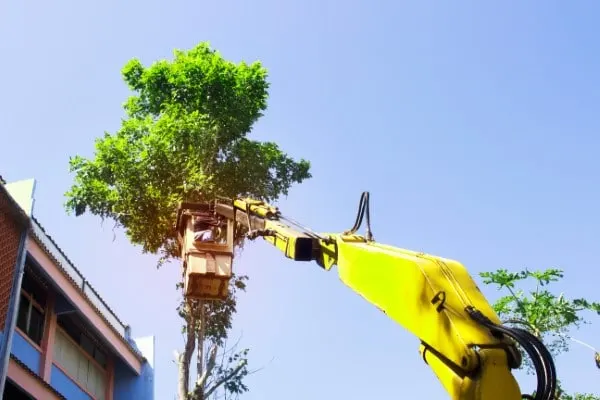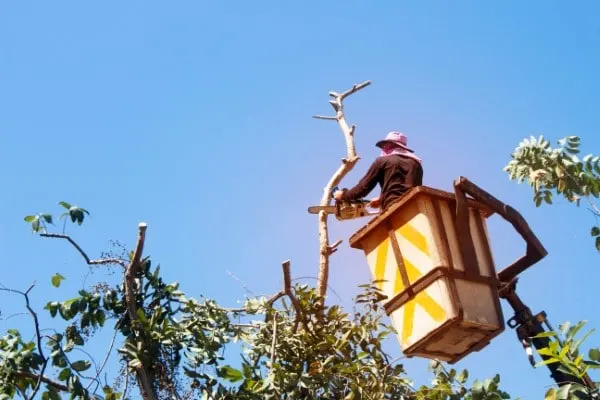Trees are an essential part of the ecosystem contributing to a healthier quality of air and improving the overall aesthetic of your landscape. However, they can sometimes be a nuisance when they grow tall and become difficult to manage. The branches extend everywhere and become gnarly and often block the windows and doorways. To get rid of this problem, learn how to trim tall trees.
Tall trees can be difficult to manage, and if they grow out of bounds, they may cause serious problems. The branches extending to the neighbor’s yard can be generally annoying. And if they extend to public property, they might block walkways and signs.
Old branches from the taller trees are also a hazard as they might fall and cause serious life or property damage. Follow our simple guide on how to trim tall trees safely like a professional.

How to Trim Tall Trees
Trimming tall trees can be challenging, and it is very important to take all safety precautions and have the right tools and experience to trim a tall tree. If you are not very good with working tools or have never done it before, it is advisable to seek professional help.
If you are annoyed by your overgrown tree, and you need to get rid of the dead branches, then follow our guide to learn how to trim tall trees.
Safety Measures Before You Begin
Here are some safety measures and precautions to ensure that the whole process goes smoothly without damage or injuries.
- Wear safety gloves before proceeding.
- Wear goggles and a safety helmet.
- Harness yourself to avoid falling from the height.
- Before you begin trimming and cutting, make sure that there are no people, pets, or cars in the vicinity that might get damaged or crushed.
- Before cutting down a dead tree, that is a falling hazard, tie it down in the opposite direction so it does not fall onto your neighbor’s property.
- Do not use a leaning ladder. Use a tripod ladder instead for better stability.
- Sharpen your tools before trimming to make the process easier.
- If any power lines pass through the tree, be careful of them. Please do not touch them or cut them.
- Have a spotter to help you. Ask someone to stand at a safe distance from the tree and guide you while you trim it. The other person can spot if the branch might fall on the property and alert you.
Items You Will Need
It is important to gear up before you endeavor such an important task.
- Safety gloves
- Goggles
- Helmet
- Safety harness
- Tripod ladder
- Chainsaw
- Hedge trimmer
- Pruning Shears and Pruning pole
- Tree wound pruning sealer
1. Examine the Tree
The First thing you need to do is examine the shape and size of the tree and see which part of the tree is obscuring the windows or extending a little too much. You will need to determine how much shaping and trimming it needs and plan out everything in advance before you start trimming.
Evaluate everything thoroughly and plan to avoid any damage, injuries, or accidents.
2. When to Trim
There is no hard and fast rule as to when you should trim your trees. If need be, you can trim your trees any time of the year. However, pruning the trees in autumn will result in slower growth due to the follow-up winter season. On the contrary, if trimming is done in winter, the tree will sprout abundantly in the following season of spring. So choose the timing according to your needs.
3. Gear Up!
Now that you have evaluated and assessed the tree and how much it needs to be trimmed, it is time to gear up. This step is particularly important for your good. Wear heavy-duty safety rubber gloves, goggles, and a strong safety helmet to avoid injuries.
Once you are geared up, wear your harness, and secure it around the tree properly. This measure is taken to ensure that no falling incident occurs.
Take the tools you need for trimming, buckle them up in your harness belt, and set up the tripod ladder as close to the tree. Make sure the ladder is on an even surface and will not tumble when you climb.
Now you are all geared up and ready to trim!

4. Start by Trimming Dead Branches
Before you begin a proper trim down, start by cutting off any dead, diseased, or wilting branches. Take your shears and cut the branch 2 inches away from the tree stem. You can cut smaller branches easily by pruning shears; however, you will need hedge trimmers or a chainsaw for large branches.
Cut off all the dead branches from the tree, and be careful while you do so. After cutting the dead branches, now it is time for the general trimming.
5. Trimming and Shaping
Now start by trimming the extended and stray branches and make your way towards the center. Make sure not to trim more than 25 percent of the tree. Take the pruning shears and cut off the stray branches. If some branches are much taller and difficult to reach, use a pruning pole to cut them.
When cutting the branches, make sure to cut them at least ¼ inches above the nearest bud. Refrain from cutting any branches above the bottom third part of the tree. Also, remember not to cut the leader branches of the trees. These branches extend at an angle of 40 degrees approximately.
Once all the extended branches are cut and the clutter has cleared, remove the treetop to decrease its height. For that purpose, you will need a hedge trimmer or a chainsaw. Be extra careful while doing this part to avoid the tree from falling onto anyone.
6. Avoid Killing or Damaging the Tree
When you are pruning a tree, you are wounding it and exposing it to the pathogens present in the environment. Trimmed tree branches and the stem are vulnerable and susceptible to various diseases and bacterial infections.
To avoid that problem, clean all of your tools thoroughly with rubbing alcohol before you start trimming. After trimming, the tree becomes weak and vulnerable, and if it catches a disease, it may even die. Use a tree wound pruning sealer and grafting compound to avoid this problem.
Apply a layer of pruning sealer on all the cut stumps, branches, and stems. It will keep the tree safe and prevent it from catching any disease. The pruning sealer will help heal the wounds and keep the tree strong and healthy.
Conclusion
You know how challenging their upkeep and maintenance are if you have tall trees growing on your property. Due to their height, they are much more difficult to reach and prune regularly. They tend to go a little hoopla and extend everywhere.
Next door, the Karen will keep annoying you until you cut your tree, or maybe the tree is unhealthy and a falling hazard.
Whatever the reason may be, we have got you covered. With our simple instructions and great tips, you now know how to trim a tall tree safely. Share your queries in the comments section.
